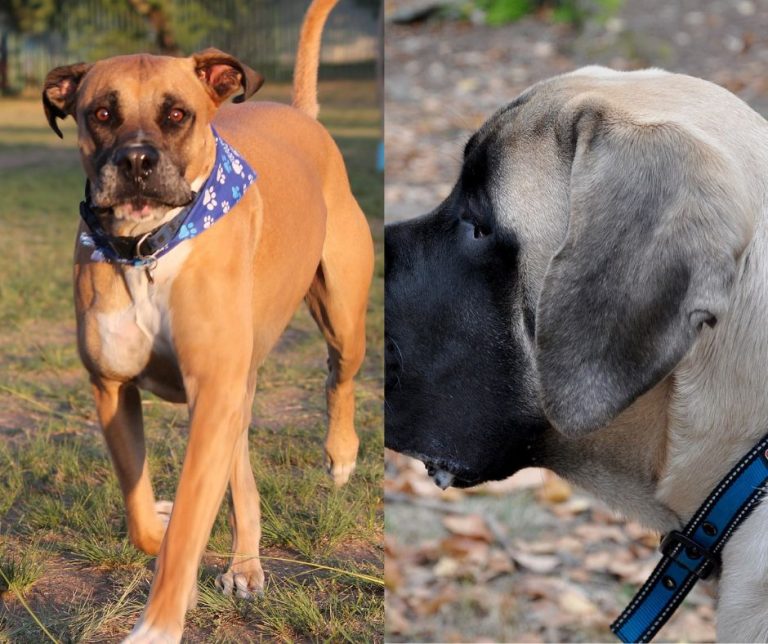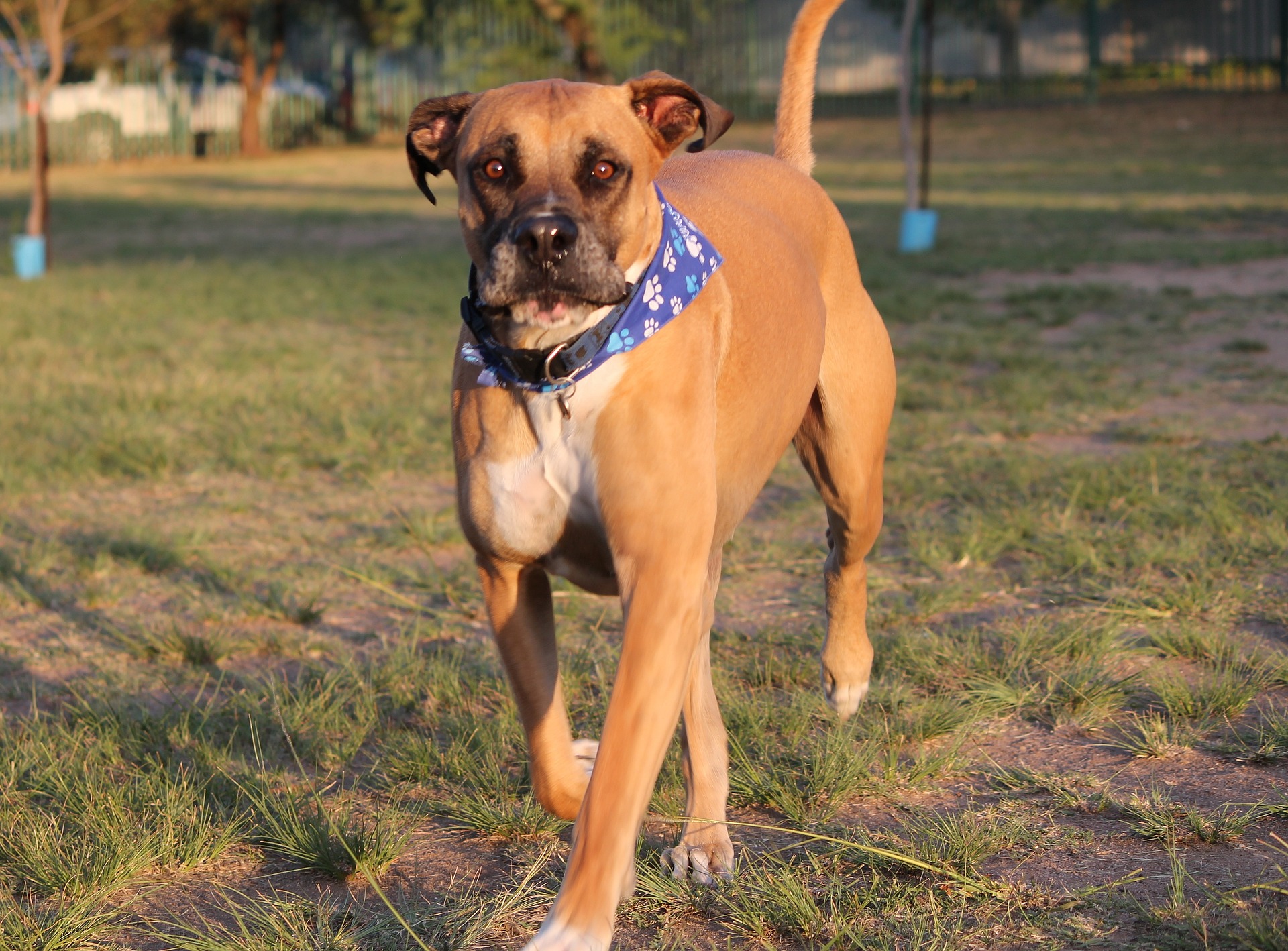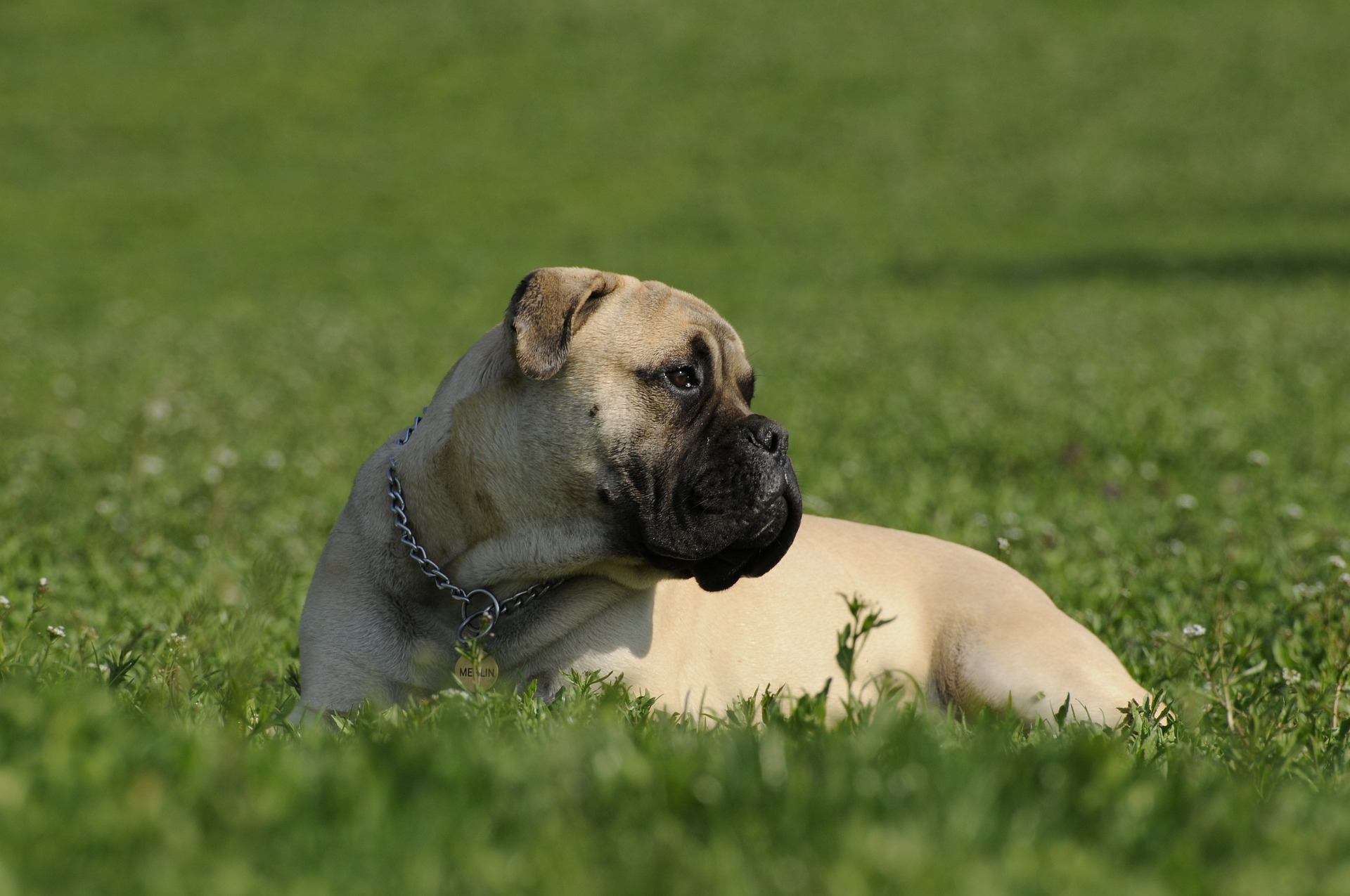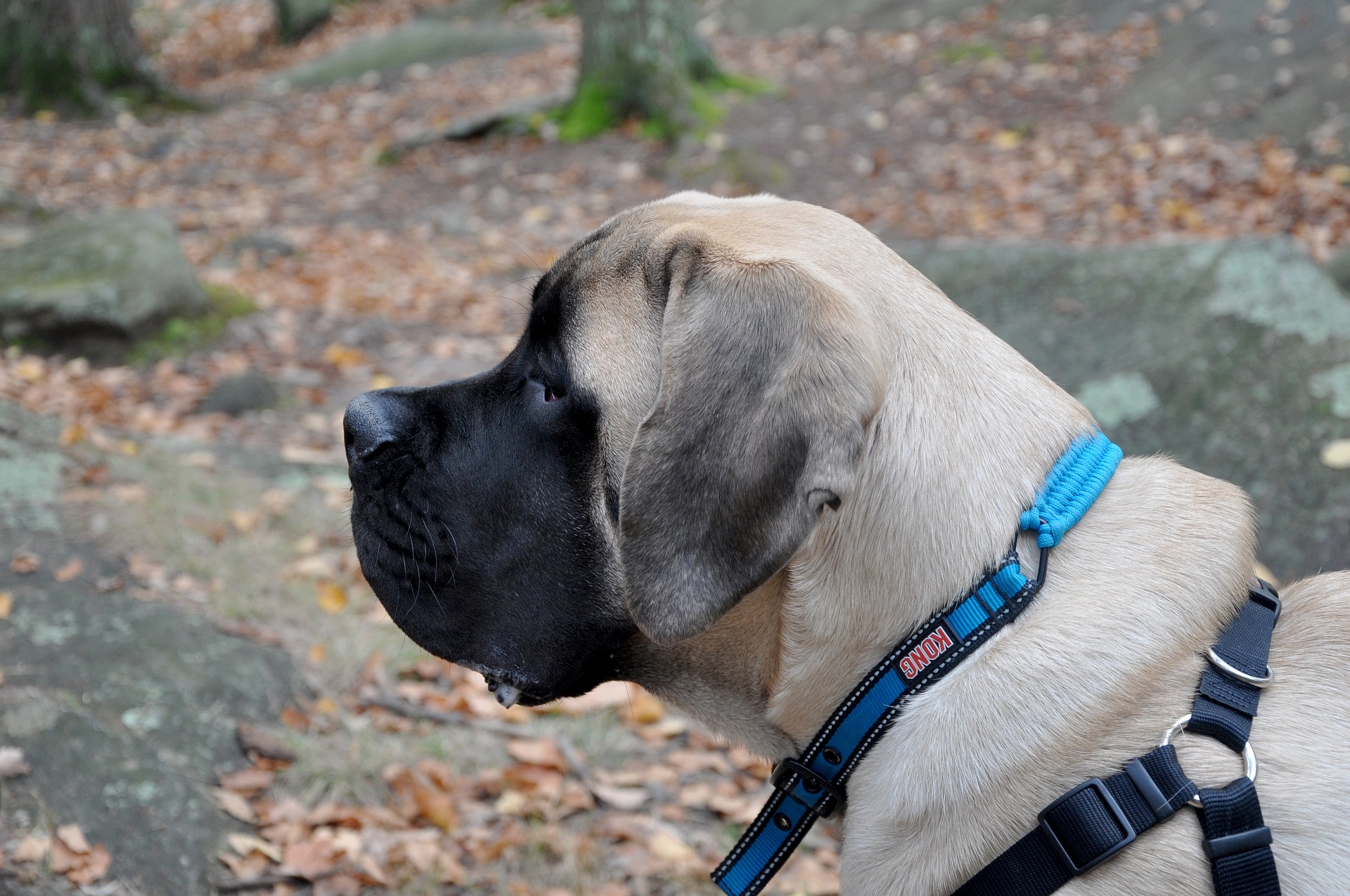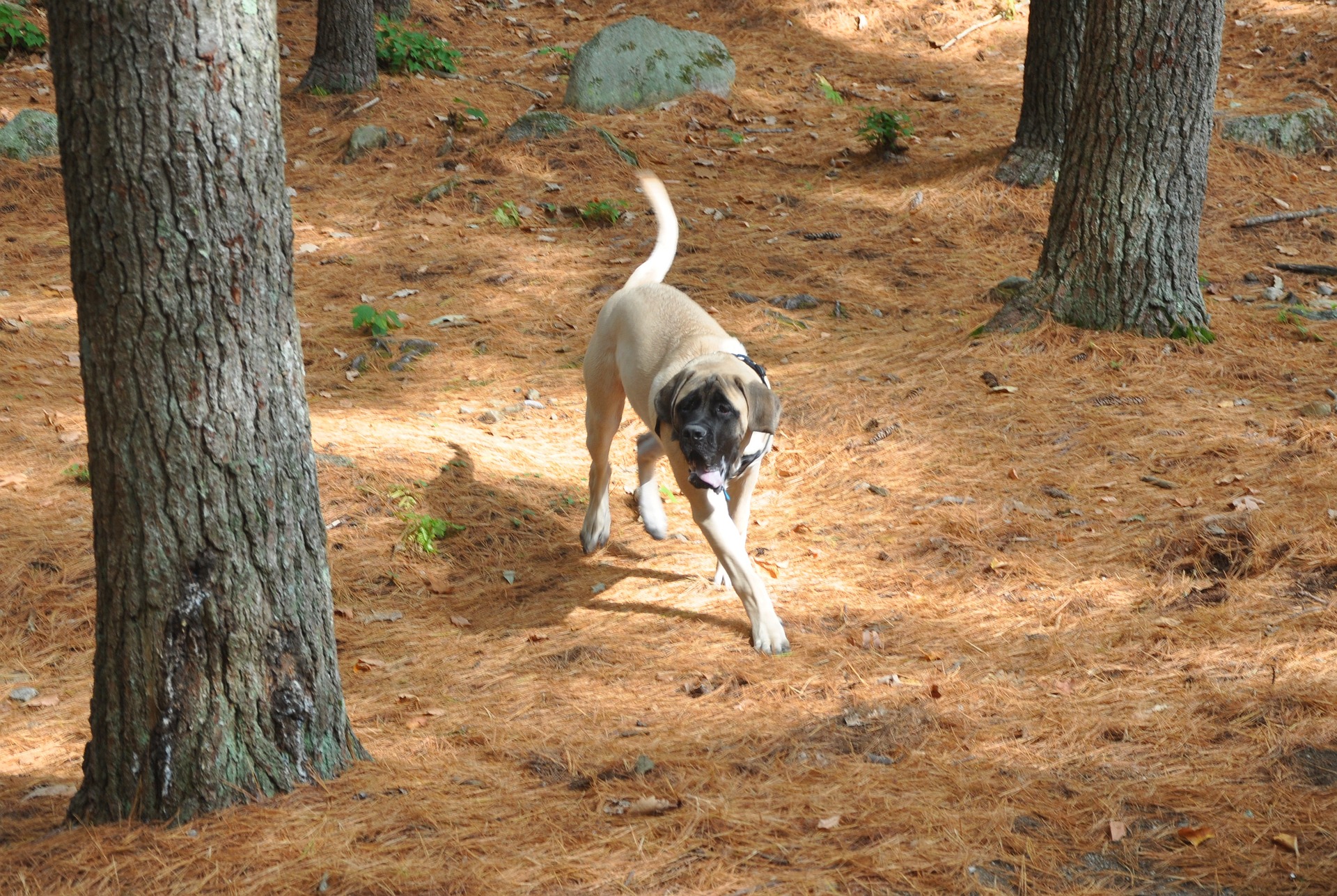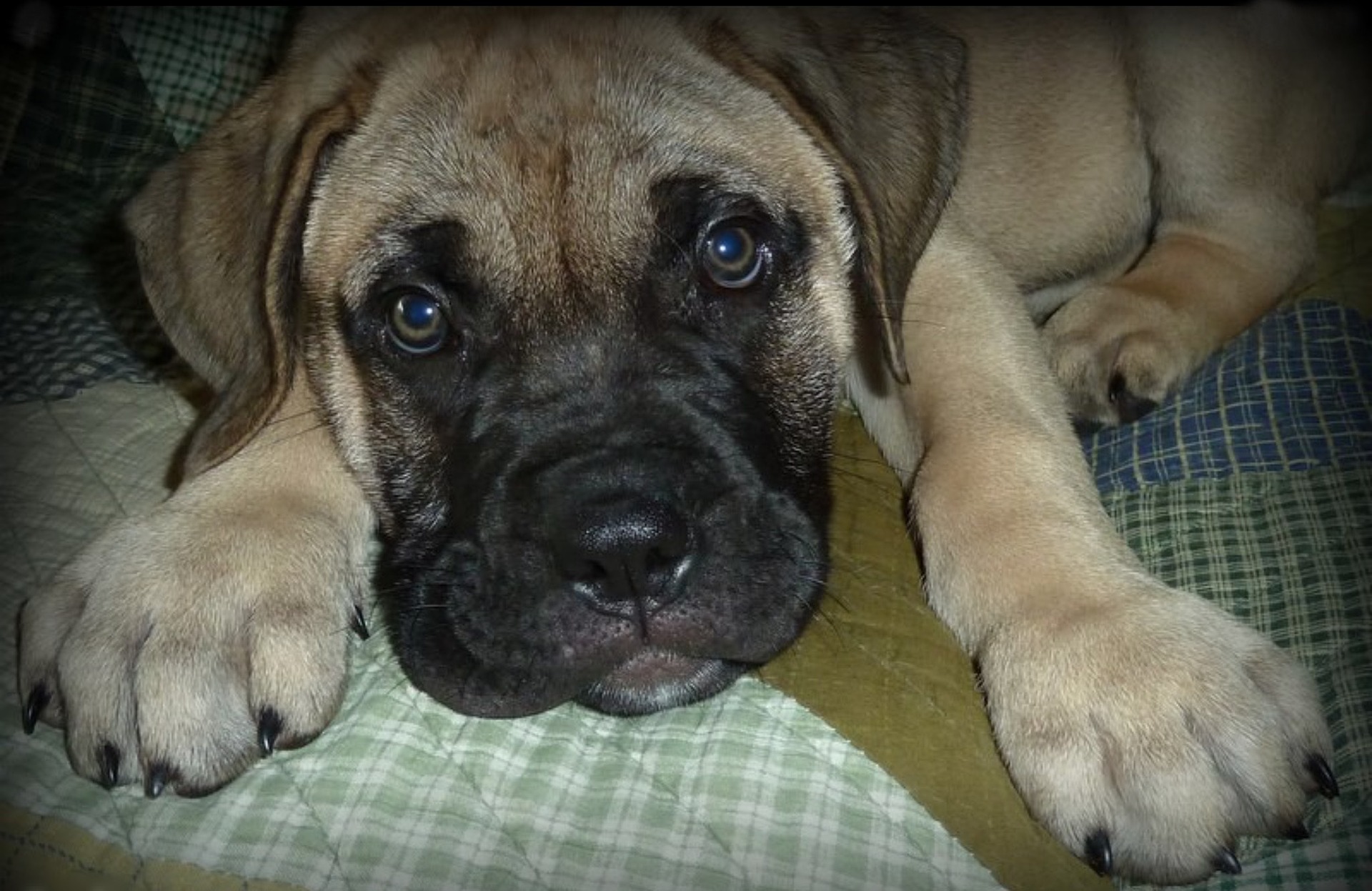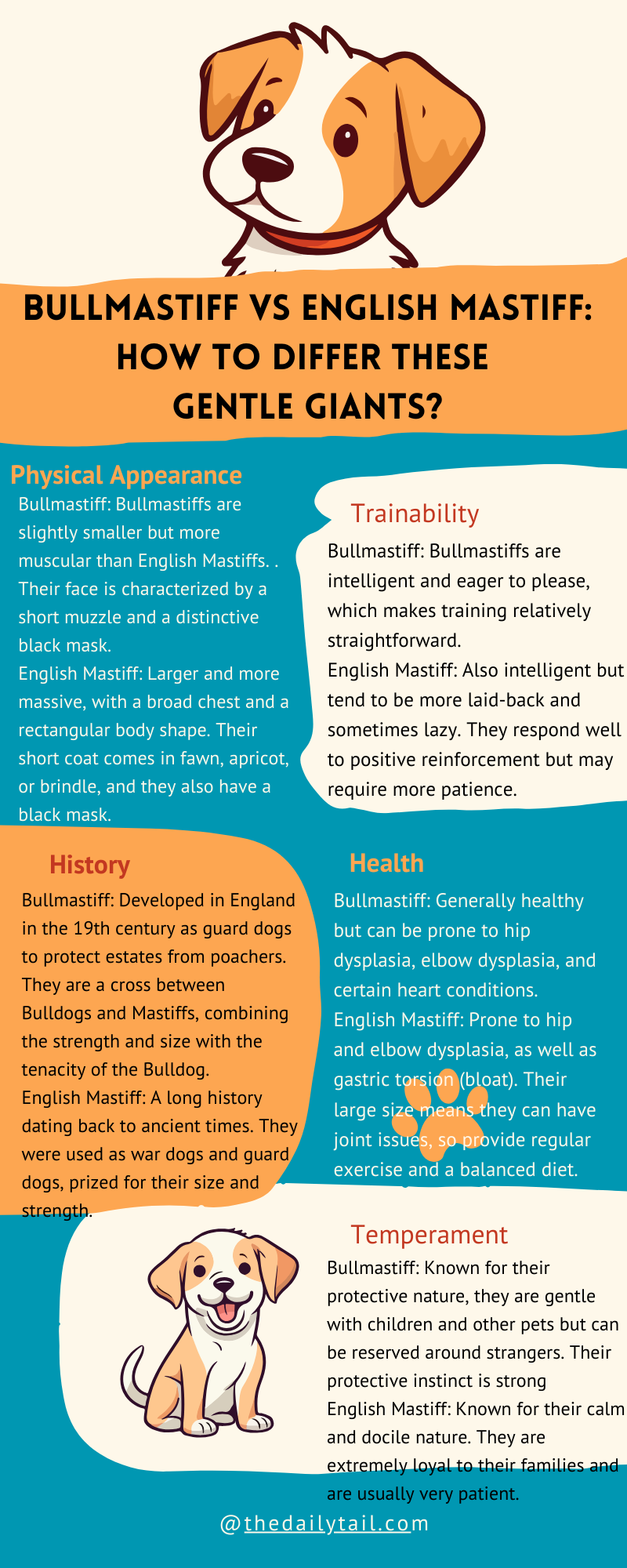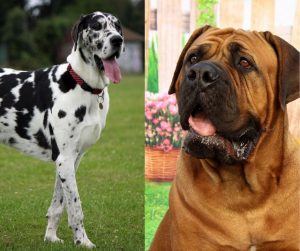When considering a gentle giant to join your family, the Mastiff breed is a popular choice. However, within this type of breed, there are distinct varieties, the English Mastiff and the Bullmastiff being the most notable.
Both breeds share a robust and powerful appearance alongside a well-mannered temperament, making them beloved by dog enthusiasts around the world.
The English Mastiff is known for its sheer size and holds the title as one of the heaviest dog breeds. These canines radiate an aura of nobility and calm strength.
On the other hand, the Bullmastiff, a blend of the English Mastiff and the English Bulldog, presents a slightly more active and protective personality. This breed was developed to assist gamekeepers in deterring poachers, which speaks to their courage and loyalty.
Choosing between an English Mastiff and a Bullmastiff really comes down to understanding their subtle differences in size, activity levels, and the potential health and maintenance requirements each breed entails. Each has its unique set of characteristics, but one thing holds true for both—their immense capacity for companionship and the heartwarming bond they can form with their dog owners.
So, let’s take a deeper look at the Bullmastiff vs English Mastiff dog breed comparison. They are both recognized by the American Kennel Club. But what is the subtle difference between the two?
Key Takeaways
- Both breeds are large, gentle, and make for great companions
- The English Mastiff is larger and more relaxed, while the Bullmastiff is more active and protective
- Prospective owners should consider size, exercise needs, and health care when choosing between the two
Breed Origins and History
Exploring the rich tapestries of the Bullmastiff and English Mastiff breeds reveals a journey through time and purpose. Both breeds share an English heritage and a lineage steeped in history, from ancient guardians to noble companions.
Bullmastiff History
Originating in England, the Bullmastiff was bred in the late 19th century. Landowners needed a dog that could track and hold poachers without causing harm. Hence, they crossed the Mastiff, known for its size and strength, with the Bulldog, valued for its bravery and tenacity.
The result was a breed that is approximately 60% Mastiff and 40% Bulldog—the powerful yet disciplined Bullmastiff.
English Mastiff History
The English Mastiff, one of the most ancient breeds, has roots that can be traced back to 2700 BC. Historically, they have been utilized as war dogs and even accompanied Roman armies, contributing to their widespread distribution. The lineage likely includes the impressive Tibetan Mastiff.
In England, their role shifted as they were used in bloodsports, notably against lions and bulls, cementing their reputation as formidable and courageous canines.
Physical Characteristics
When comparing the Bullmastiff to the English Mastiff, one will notice that these gentle giants have notable differences in their physical makeup. Here’s a closer look at their size and weight, coats and colors, and other visual distinctives.
Size and Weight
The English Mastiff holds the title for larger mass. Males can tip the scales at a hefty 160 to 230 pounds, standing 30 inches and taller at the shoulder. Females are not far behind, generally weighing between 120 and 170 pounds.
In contrast, the Bullmastiff is a bit more compact. Males rarely exceed 130 pounds, and females often weigh around 100 pounds, with a height typically less than 27 inches for males and 26 inches for females.
- English Mastiff
- Male: 160-230 lbs, 30+ inches
- Female: 120-170 lbs, 27.5+ inches
- Bullmastiff
- Male: 110-130 lbs, up to 27 inches
- Female: 100-120 lbs, up to 26 inches
Coat and Color
Both breeds have short, manageable coats, but there’s a slight difference in texture; the Bullmastiff’s coat tends to be a bit rougher compared to the English Mastiff’s smoother finish.
As for color, they share similar shades. One can find them in fawn, brindle, and a deep reddish-brown often referred to as red. However, the English Mastiff’s palette can sometimes showcase a distinctive apricot hue.
- Coat Texture:
- English Mastiff: Smooth
- Bullmastiff: Slightly rougher
- Common Colors:
- Fawn
- Brindle
- Red
- English Mastiff may also display Apricot
Visual Differences
Visually, both breeds exude an impressive and powerful presence. The English Mastiff’s sheer size and large square head give it a dignified yet formidable appearance. Their eyes are set apart, giving a good-natured expression.
The Bullmastiff, while still large, looks a bit more athletic with a solid build and a shorter muzzle, paired with a black mask that often covers the face, making them stand out. They carry a stance that is confident and alert, reflecting their origin as estate guardians.
Bullmastiff vs English Mastiff Personality and Temperament
When contemplating a Bullmastiff or an English Mastiff, potential pet owners should consider these breeds’ distinct personalities. While both breeds are known for their loyalty and protective nature, they vary in energy levels and expressions of affection.
Bullmastiff Temperament
The Bullmastiff is known for its active and protective temperament. They display loyalty to their families and are natural protectors of their home.
Bold yet affectionate, these dogs require ample exercise and mental stimulation to thrive. A distinct trait is their territorial instinct; they are vigilant without being overly aggressive.
A play session in the morning and a brisk walk in the afternoon typically suffice to meet their physical needs.
English Mastiff Temperament
In contrast, the English Mastiff’s temperament is often described as that of a gentle giant. This breed is affectionate and loyal, but tends to be more laid-back or even stubborn at times.
English Mastiffs are known for being less active, content with being home and enjoying relaxation. Their sheer size demands respect, but their temperament is often calm, making them suitable companions for those looking for a less active dog.
Despite their size, they exhibit a gentle demeanor, especially around family.
Health and Wellness
When it comes to health and wellness, both the Bullmastiff and the English Mastiff share some common issues, but they also have concerns unique to their breed. Regular veterinary check-ups and a watchful eye on their well-being can ensure a happier, healthier life for these gentle giants.
Common Health Problems
The Bullmastiff and the English Mastiff are prone to certain health problems that future owners should be aware of. These breeds both have a risk of developing:
- Cancer: A leading cause of death, particularly lymphoma and mast cell tumors
- Bloat (Gastric Dilatation-Volvulus): This life-threatening condition is a concern due to their large chest cavity
- Hip Dysplasia: A malformation of the hip joint that can lead to arthritis or lameness
- Elbow Dysplasia: Similar to hip dysplasia, but affects the elbow joints
Breeding practices and regular health screening can help mitigate the risks of these conditions. A balanced diet and appropriate exercise are also crucial to maintain their joint health and overall wellness.
Lifespan
Despite their imposing size, members of both breeds tend to have a medium lifespan for dogs:
- Bullmastiff: They typically live between 8 to 10 years
- English Mastiff: Their lifespan is often in the range of 6 to 12 years
Factors such as genetics, environment, and overall health care can influence their longevity. It’s key for an owner to understand while these dogs bring a lot of love, their time might be more limited compared to smaller breeds.
Bullmastiff vs English Mastiff Training and Exercise Needs
Choosing between a Bullmastiff and an English Mastiff? It’s essential to understand their training and exercise needs to ensure they’re happy, healthy companions. Let’s dive into what it takes to bring out the best in these gentle giants.
Training Requirements
When it comes to training, these breeds have quite different requirements.
The Bullmastiff thrives on consistent, firm training sessions. They were bred as working dogs, employed to track and hold poachers without causing harm.
This background makes them responsive to obedience training but also means they can be willful if the trainer is not confident and consistent.
On the other hand, the English Mastiff’s training also hinges on early socialization. Their immense size makes it crucial to teach them proper manners from a young age.
While being naturally well-tempered, they can be a bit stubborn, so patience and consistency are your best training tools.
Exercise Requirements
Their exercise needs reflect their energy levels.
A Bullmastiff’s energy levels are somewhat higher than that of an English Mastiff, requiring more daily activity.
A structured play session in the morning, plus a brisk walk in the afternoon, will keep them in good shape.
Meanwhile, the English Mastiff doesn’t need quite as much activity. This breed might act lazy at times, preferring to lounge around the house. However, they still need regular exercise to maintain proper health and avoid weight issues.
Casual walks and the opportunity to roam in a secure area are typically sufficient to meet their exercise needs.
Breed Trainability
Their trainability is a factor of their background and temperament. Bullmastiffs tend to be more assertive and protective. This means they can take to training well, but they may test boundaries if they sense hesitation. They are keen learners and respond well to positive reinforcement techniques such as treats and praise.
English Mastiffs, due to their more laid-back nature, might not seem as immediately responsive to training. Their calm disposition means they may take commands in stride, but they’ll need consistent and repetitive training sessions. Remember, they’re eager to please their owners, and with gentle encouragement, they can excel in obedience training.
Both dog breeds benefit immensely from early socialization — exposure to different people, settings, and situations — to ensure they grow up well-rounded.
Living Conditions
When considering whether a Bullmastiff or an English Mastiff will fit into one’s home, understanding their living conditions is essential. These dogs are sizable companions, so their comfort and welfare depend heavily on the type of environment they reside in.
Suitable Environments
For the Bullmastiff, they adapt well to various surroundings, including smaller spaces. However, they still require an environment that allows for regular exercise. Their sturdy build and protective demeanor make them excellent watchdogs for family homes.
In contrast, the English Mastiff thrives in a more spacious setting where they can stretch out and move freely. Given their grand size, they are naturally suited to houses with large yards. Both breeds are known for being family-friendly; they develop strong bonds with family members, showing affection and loyalty.
Apartment Living
Apartment living can be suitable for these breeds, with considerations:
- Bullmastiff:
- Adaptable to apartments due to their relatively moderate activity level
- Regular walks and mental stimulation are crucial to keep them happy
- English Mastiff:
- They may find apartment living more challenging due to their larger size and need for space
- They require easy access to outdoor areas for exercise
An English Mastiff can live in an apartment, but it’s essential for their wellbeing to have adequate space to lie down and move around comfortably. Regular outings are non-negotiable to maintain their health. In essence, the key to harmonious apartment living with these gentle giants is to balance their size and exercise needs with the available living space.
Care and Maintenance
When it comes to the loveable Bullmastiff vs English Mastiff, taking good care of their big, cuddly selves means understanding their grooming and nutritional needs. The proper approach ensures they stay healthy, shiny, and ready for endless snuggles.
Grooming Needs
Both the Bullmastiff and English Mastiff dog breed have coats that are pretty low-maintenance, but they do have their differences. The Bullmastiff, with a shorter coat, requires regular brushing—about once a week—to keep their coat shiny and to minimize shedding. A soft bristle brush or hound glove will do the trick.
The English Mastiff, while also not known for a demanding grooming schedule, can benefit from a bit more frequent brushing to manage their marginally heavier shedding. They appreciate a good rubdown with a sturdy bristled brush that reaches their undercoat, especially during seasonal changes when shedding can increase.
In both breeds, regular ear checks, nail trims, and dental care are non-negotiable for their wellbeing. This basic grooming routine will keep them looking their best and prevent common health issues.
Nutritional Requirements
When it comes to dinner time, these gentle giants need a carefully measured feast to match their size and energy levels. They both thrive on high-quality dog food that is rich in nutrients, but portions and specific needs can differ.
Bullmastiffs are active and thus may require a diet with a bit more calories or protein to support their energy. However, it’s crucial not to overfeed, as their enthusiasm for food could lead to obesity.
- Sample Bullmastiff Diet:
- Breakfast: 2 cups of high-protein dog kibble
- Dinner: 2 cups of kibble plus lean meat
The English Mastiff tends to be more laid-back and may not burn through calories as quickly. They need well-balanced meals that support their immense size, but with careful monitoring to maintain a healthy weight.
- Sample English Mastiff Diet:
- Breakfast: 1.5 cups of nutrient-rich dog kibble
- Dinner: 1.5 cups of kibble with a focus on vitamins and minerals
Always ensure clean, fresh water is available, as both breeds need to stay hydrated. Consulting with a veterinarian can help tailor a diet that’s perfect for your furry friend’s specific health requirements.
Ownership and Costs
When deciding to welcome a new four-legged family member into one’s home, it’s not just about picking the cutest pup. They must consider what’s really involved, especially financially. It’s beyond the initial payment; they’re looking at a commitment that includes food, care, and those unexpected vet visits. But let’s break down those first crucial costs involving breeders and puppy prices.
Breeders and Puppy Prices
For families interested in an English Mastiff or Bullmastiff, it’s essential to connect with reputable breeders. These breeds differ in price, with prices reflecting factors like lineage and breeder reputation. An English Mastiff puppy typically starts at about $1,500, with the potential to climb if they come from champion lines. On the flip side, Bullmastiff puppies are a tad more wallet-friendly at the start, with prices beginning at around $1,000 from a breeder.
A breakdown of the expected costs for each breed from a breeder could look like this:
| Breed | Starting Price | Champion Lineage Price |
|---|---|---|
| English Mastiff | $1,500 | > $2,000 |
| Bullmastiff | $1,000 | > $2,000 |
Getting a purebred from a trustworthy breeder might cost more upfront, but it can mean better health and temperament for their furry friend, which ultimately can be cost-saving down the line. Plus, they’re not just buying a puppy; they’re investing in a loyal companion for years to come.
Final Thoughts
When choosing between the English Mastiff and the Bullmastiff as a family dog, pet owners should consider their lifestyles and preferences.
Both breeds share a rich history. Bullmastiffs initially served as guard dogs for gamekeepers to deter poaching, while English Mastiffs were noted for their imposing presence and guarding capabilities.
Regarding companionship, they both offer loyalty and affection. They’re known for being gentle giants, fitting well in homes with adequate space.
Despite their size, they can adapt to being around other pets if properly introduced and socialized.
Their short coats require minimal grooming, making them a convenient choice for families not wanting to manage extensive grooming needs.
Both breeds, however, differ slightly in size and exercise requirements, with the English Mastiff being larger than the Bullmastiff.
Considering guard dogs in the broader spectrum, it has been observed that breeds like the Cane Corso or Great Dane share similar protective traits, but the temperaments can vary. Therefore, understanding each breed’s unique nature is key.
Families should weigh these factors, recognizing that both the English Mastiff and Bullmastiff are not just pets but lifelong companions.
They demand love, patience, and understanding, but in return, provide unwavering devotion and protection to their human pack.
When deciding, think about the love and the commitment required to ensure a happy home for these noble dogs.

